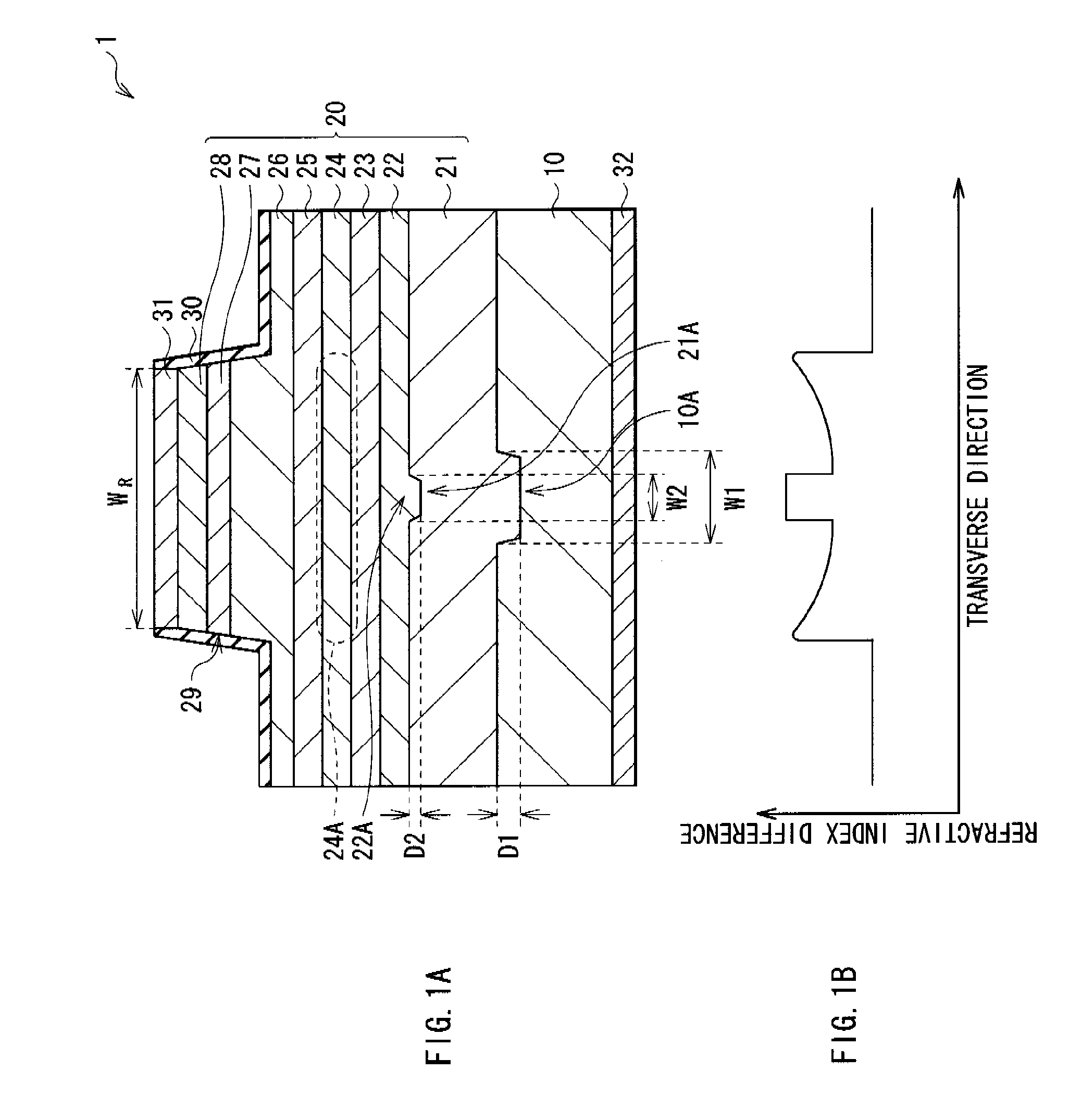Laser diode and method of manufacturing the same
- Summary
- Abstract
- Description
- Claims
- Application Information
AI Technical Summary
Benefits of technology
Problems solved by technology
Method used
Image
Examples
first embodiment
Modification of First Embodiment
[0069]In the first embodiment, although only one convex portion 22A (the concave portion 21A and the concave portion 10A) is formed, two convex portions 22A may be formed in the central part, for example, as shown in FIG. 4A or three or more convex portions 22A may be formed. In the case where the two convex portions 22A (the concave portions 21A and the concave portions 10A) are formed in the central part, the refractive index distribution is, for example, as shown in FIG. 4B.
[0070]In the first embodiment, although the convex portion 22A is projected to the semiconductor substrate 10 side, the convex portion, instead of the concave portion 10A, may be provided on the semiconductor substrate 10, and the concave portion may be provided corresponding to the convex portion, on the interface of the first lower guide layer 22 on the semiconductor substrate 10 side. In this case, on the interface of the lower cladding layer 21 on the first lower guide layer...
second embodiment
Modification of Second embodiment
[0083]In the second embodiment, the concave portions 33 are formed in the vicinity of both ends in the width direction of the ridge 29, and the narrow-stripe ridge portions 29A and 29C are provided at both ends of the broad-area ridge portion 29B. Thereby, the intensity of the transverse mode in the gain region in the central part and the intensity of the transverse mode in the index region at both ends are in good balance. However, as shown in a laser diode 3 in FIG. 10A, instead of the concave portions 33, a strip-shaped electrode (an upper electrode layer 31) may be provided only on the upper surface of the central part where the ridge portion 29B of the ridge 29 is provided. The refractive index distribution of the laser diode 3 of FIG. 10A is shown in FIG. 10B. Even in this case, the current is actively injected into the gain region in the central part, from the upper electrode layer 31, and the amount of the current injected into the index regi...
third embodiment
Modification of Third Embodiment
[0098]In the third embodiment, although one convex portion 22A (the concave portion 21A and the concave portion 10A) is formed, two or more convex portions 22A may be formed. For example, in the case where the two convex portions 22A are provided as shown in FIG. 16A, a space W1 between the two convex portions 22A may have a width larger than a width (a width of a portion of an upper electrode layer 34 which is in contact with a contact layer 28) of an upper electrode layer 34. FIG. 16B shows a refractive index distribution of the laser diode of FIG. 16A.
[0099]In this case, the width of the transverse mode is defined by the space Wi, and the width of the transverse mode is suppressed from being larger than the space Wi. For example, in the case where the two convex portions 22A are provided, the width of the space Wi between the two convex portions 22A may be almost equal to the width (a width of a portion of the upper electrode layer 34 in contact wi...
PUM
 Login to View More
Login to View More Abstract
Description
Claims
Application Information
 Login to View More
Login to View More - R&D Engineer
- R&D Manager
- IP Professional
- Industry Leading Data Capabilities
- Powerful AI technology
- Patent DNA Extraction
Browse by: Latest US Patents, China's latest patents, Technical Efficacy Thesaurus, Application Domain, Technology Topic, Popular Technical Reports.
© 2024 PatSnap. All rights reserved.Legal|Privacy policy|Modern Slavery Act Transparency Statement|Sitemap|About US| Contact US: help@patsnap.com










